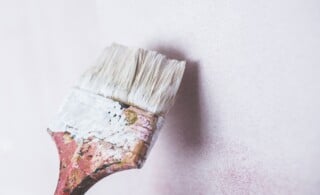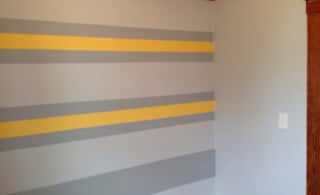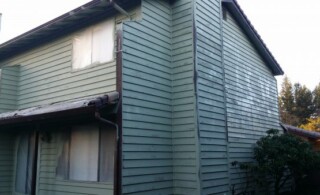
An open wall sits before you, just begging for a little color. Your hands are itching to grab a paintbrush and get started. As tempting as it may be to get the job done quickly, taking your time is exactly how the project will turn out the way you want it to. Rush through painting, and odds are you will have a lot of touch-up work and unnecessary cleaning afterward.
Following this advice will give you a room that looks like a professional did the job:
- Know Your Paint
- Preparing
- Clearing the Room
- Tape & Covering
- Making Repairs
- Getting Started
- Rolling
- Finishing Up
- Tips For Touching Up Paint Video
1. Know Your Paint
Giving a room a makeover is not as simple as walking into a paint store and picking out a color of any old gallon. There are different finishes that provide certain advantages. Consider:
- Flat: Ideal for ceilings and bedrooms as well as walls that have imperfections. Easy to touch up, hard to clean.
- Eggshell: Provides a low-sheen finish but is not ideal for high-traffic areas because it can get tainted quickly. Also easy to touch up and has a washable finish.
- Satin: Has a silky sheen that works well on woodwork and in high-traffic areas, the kitchen and bathrooms. Very easy to clean but can be difficult to touch up.
- Semi-gloss: Best for moldings and trim, but may be used in areas with high humidity, such as the kitchen. Easy to clean but, like satin, is hard to touch up.
- Gloss: Steer clear of gloss paint for walls, because its finish will show any imperfection. This is best reserved for trim work.
You also have a choice of oil-based or water-based (latex) paint. Latex dries quickly and is easy to work with, but oil-based paint is durable. Generally, people use latex on walls and oil-based paints on trim.
If you aren’t sure which finish may be best, ask a painting contractor. Once you select your paint, ask which brushes and rollers will work best with it. These tools have varying fibers that are ideal for certain walls and paint finishes. For example, natural brushes work well with oil-based paint, and synthetic brushes work best with latex or water-based paint.
Ready to start your painting project?
Find Pros2. Be Prepared
Put together all your supplies before you ever open that can of paint. The necessary items include paint, brushes, rollers, tape, drop cloths and a screwdriver for removing fixtures. It is also handy to have some clean towels and a jar of water in the room, which can help you quickly wipe up any spill.
3. Clear the Room
If you want to do the job like a pro, you will need to prep the room the way a professional does. That means taking all the items off the walls, such as outlet covers, light switch covers, pictures, sconces and anything else that could get in your way.
You should also move all the furniture either out of the room or to the middle of the room, giving yourself ample room to move freely. A good rule of thumb is to be able to stand between the wall and a piece of furniture with your arms extended, one hand on the wall and one on the furniture.
4. Tape and Cover
While many professional painters may not even tape because they are just that good, chances are you have not spent your career perfecting your brush stroke. Therefore, tape, tape, tape. Make sure to get quality painter’s tape and use it along windowsills, baseboards, wainscoting, door frames, ceiling moldings or any other feature in the room that you need to protect.
If you have left anything in the room, cover it with a drop cloth, plastic or old sheets. It may seem as though the items in the middle of the room are out of harm’s way, but paint splatters can show up where you least expect them. It is better to cover it up now than have to do some hard scrubbing later.
5. Make Any Repairs
Thoroughly inspect the walls. Do you see any rough patches? Any nail holes? Flaking old paint? The best paint jobs are the ones done on a clean, smooth surface. Plaster and patch damaged areas and sand away other rough spots. Wait to paint until these areas are dry.
6. Get Started
You are finally ready to start painting. Start with doing trimming the frame of the room. Use a brush that is 2 to 3 inches wide with a straight edge along your doors and window frames as well as in the corners and along the ceiling. If you have a lot of detailed areas or obstructions, be sure to have a sash brush, which is roughly 1½ inches wide and has an angle, which makes it ideal for cutting in around complex areas.
To prevent getting too much paint on your brush and risking drips, dip the bristles just a third of the way in to the bucket and pull the brush back against the rim of the paint bucket. Use long, smooth brush strokes on the wall, which will prevent streaking.
7. Ready to Roll
Once all your trim work is done, you can break out the rollers. A 12-inch roller should suffice for your job, and, like with brushes, it is important not to overload it with paint. Run the roller over the tray to remove any excess paint before taking it to the wall.
The best way to roll on paint is to do it in an overlapping “W” pattern, making the letter on the wall over and over. After four or five letters, go back and re-roll the area with vertical strokes. This method prevents patchy spots, but you should be prepared to do a second coat, even with paint that guarantees just one is necessary.
Ready to start your painting project?
Find Pros8. Finishing Up
After the walls are completely dry, you can remove the tape. Take your time and do it slowly, as ripping it away quickly can damage your paint job or leave small pieces of tape behind. If the tape is being stubborn, use a hair dryer to loosen the bond.
You can clean your brushes by soaking the bristles in water or paint solvent for at least 30 minutes. Then rinse out all the paint and dry it with a clean towel. To keep the bristles straight, wrap them in plastic wrap.
Painting a room yourself may take time, but it can save you a significant amount of money. You can get professional results by simply having some patience and following these tips.
 Creating a Kid’s Fantasy World With Themed Murals
Creating a Kid’s Fantasy World With Themed Murals  Exterior Painting Techniques
Exterior Painting Techniques  Choosing Exterior Paint Colors
Choosing Exterior Paint Colors  Step by Step Guide to Painting
Step by Step Guide to Painting  Removing Exterior Paint or Stain
Removing Exterior Paint or Stain 

My husband and I have been wanting to do some painting in our home for a few months now. All of our walls are currently white and it just doesn’t look very appealing. We have been thinking about going with more of a brownish color too soften things up. Neither of us have much experience with interior painting so I think that these tips will be really helpful. Thank you for sharing!
I really agree with the idea of making repairs before you start painting. That way you can do a more even smoother coat of paint. I also think that it is important to sand down any bumpy areas before painting. I appreciate you pointing out some of the smaller details as to what I could do for making my home easy to paint.
I agree that you should get to know your paint. I think asking for samples really can help with that. That way you can feel and see what it looks like on your wall.
Thank you for the help. My wife and I are wanting to do some interior painting sometime in the near future. I admit that I know almost nothing about the paint itself. It sounds like eggshell may be a good choice. Would you consider that a durable paint option?
I’m not a pro, but I have painted a lot of rooms over the years – more years than I care to think about. I would like to add a couple of comments based on my experience:
(1) If you have to repair damaged walls (nail holes from hanging artwork, hairline cracks, minor dings, impressions from doorknobs, electrical modifications) marching the texture on an existing surface is often a challenge. I use water-based spackling and clean up after it dries with a damp rag. If the damage isn’t too big you can make it pretty much disappear; If you sand the dried spackle you will create a much larger flat spot that will be harder to blend into the existing texture. If you need to cut out a small area of drywall (for instance to access electrical ‘stuff’ inside a wall) , do so with a utility knife, being as neat as possible. The piece of drywall can be glued back into place, spackled and finished with a damp rag, thus preserving the texture on it. I glue pieces of scrap wood into the hole using c-clamps to make a support for the drywall repair. You need to be careful to reinstall the piece of drywall flush with the wall, but it’s a lot easier than using joint compound to make a flush repair that then has to be textured.
(2) I disagree with the advice to let the paint dry before removing tape. I have read that the tape should be removed – carefully – while the paint is still somewhat wet to prevent chipping of the paint when removing the tape, and I find that this does work better. However, the disadvantage is that the wet paint on the tape can be – actually will be – messy, so you need to be careful to avoid painting yourself, the walls, or anything else in the vicinity with the tape.
(3) A final tip – if you are installing doorstops that screw into the baseboards, consider attaching them to the doors instead – this makes it easier to vacuum, wash or wax the floor.